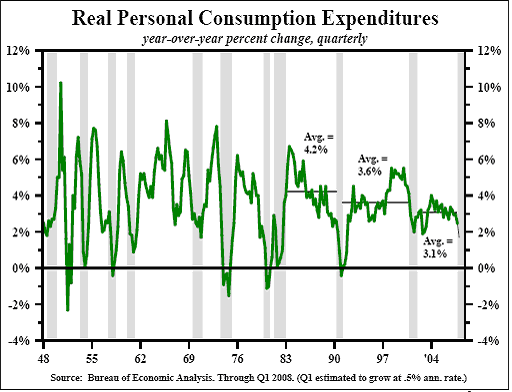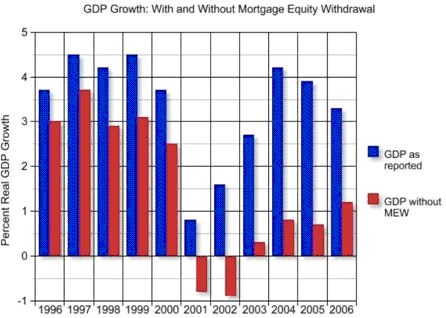Consumers Will Lead the Way to Economic Recovery
Economics / Recession 2008 - 2010 May 27, 2009 - 06:25 PM GMTBy: Hans_Wagner
 In recent recessions, consumer spending led the economy in the recovery. Many investors are counting on the same thing, taking place during this recovery. They will be disappointed.
In recent recessions, consumer spending led the economy in the recovery. Many investors are counting on the same thing, taking place during this recovery. They will be disappointed.
A Look Back
Before the latest recession consumer spending accounted for more than 71% of the Gross domestic Product (GDP) in the U.S. According to the Bureau of Economic Analysis, in 1970 consumer spending rose to 64.8 percent of GDP. The baby boomer generation was a force in the U.S. economy and they had never experienced a severe depression such as what took place in the 1930’s. The share increased to 65.2 percent in 1980 and 66.7 percent in 1990. In the economic expansion of the 1990s, along with rising disposable incomes, consumer spending as a portion of the GDP increased to 67.8 percent by 2000.
As shown in the chart below the average Real Personal Consumption Expenditures in each of the most recent expansions has declined from an average of 4.2% in the 1983 to 1990 expansion to 3.1% during the latest expansion. The chart below is from John Mauldin’s “Outside the Box” April 21, 2008.
In the latest expansion, real wage and salary income rose just 1.8%, caused by only a 0.8% growth in payroll employment, the smallest of any expansion since World War II. This is a real concern for the U.S. economy both now and in the future.

What makes the situation even more of a concern is the PCE would have been worse. From 2000 to 2007, consumers took advantage of the rising values of their homes to extract cash through refinancing. The housing and credit crisis we are now experiencing put a stop to this source of cash for consumers. The following chart is from John Mauldin’s Weekly E-Letter, Front Line Thoughts, April 18, 2008. It shows GDP as reported by the government and what the GDP would have been if consumers had not removed cash from the value of their homes and spent it. While the mortgage equity withdrawal has been an on going event, it became a much bigger part of the growth in the US’s GDP starting in 2002. At best, the GDP grew at slightly over 1% after 2000 without extraction of money from increasing home values. The message is the economy did not have significant strength to grow on its own without the increasing leverage taken on by homeowners.
The extraction of cash for an asset that increases in value works as long as the asset continues to grow. When it slows down or reverses course, that source of funds is no longer available. Consumers cannot maintain their level of spending when it depends on the value of their homes increasing at unsustainable rates.

Role of the Consumer in the Next Recovery
This raises the question, what will drive the growth of the economy going forward. According to the Congressional Budget Office (CBO), GDP growth will jump up to 3.8% in 2010 and 4.5% in 2011. Interestingly, they project unemployment of 8.8% for 2009 and that it will rise to 9% in 2010. By the way, unemployment is already 8.9% and is expected to rise further as job losses remain at or above 600,000 per month. In addition, there is a growing population of under-employed that is reaching 15% of the total employed. Many of these people come from high paying jobs, which required them to pay a fair amount of taxes. There are automotive engineers driving taxis, securities traders working at grocery stores and chemists working in call centers. Their industries have cut back and they are unlikely to see new opportunities for some time. The economic stimulus that is funding shovel ready construction protects is not likely to offer these people new opportunities. Many unemployed construction workers will find new work, which is a good thing. However, we should not expect this money to generate work for the many of the unemployed and underemployed. Even the CBO agrees
President Obama has indicated he wants to create millions of green jobs to help wean the U.S. off its overwhelming dependence on oil. It is a laudable endeavor. However, according to a study by Gabriel Calzada Alvarez and economic professor at King Juan Carlos University, it has cost Spain, a leading green energy country approximately $770,000 for each new green job that has been produced. Had the money been spent on other parts of the economy it would have produced 2.2 new jobs. Many people in the administration use Spain as a model for the U.S. If this study is even partly right, it will not be the engine of new jobs as many have hoped. Maybe, some new inventions will come to the rescue. Without then the economy will struggle to recovery.
The stock market crash coupled with the crash in housing prices has had a devastating affect on the finances of consumers. They know that and realize they must save and invest smartly to recover. Consumers are curtailing their spending to provide some of the money to save. They also realize it will take many years for them to recover. This means we should expect many years with lower spending on goods and services by consumers.
Consumer spending is slowing and it will stay restrained for years. In the 1980’s consumers saved 7 – 10% of their incomes. At that time, consumer spending accounted for 63% of the GDP. Now that consumers no longer can depend on their homes to fund their spending and their retirement, they will curtail their spending and increase their savings. I believe the percentage of consumer spending that is part of the GDP will slowly return to the mid 60s over the next several years.
The Bottom Line
Since expansion of consumer spending will not be available to drive the economy, investors will need to look to other segments. The problem is as consumer spending is such a large part of the economy. As they curtail their spending, there isn’t another area that can step in and replace the gap. Even the administrations desire to build a green economy will not be able to make a difference. Investors need to adjust their strategies to recognize this reality.
By Hans Wagner
tradingonlinemarkets.com
My Name is Hans Wagner and as a long time investor, I was fortunate to retire at 55. I believe you can employ simple investment principles to find and evaluate companies before committing one's hard earned money. Recently, after my children and their friends graduated from college, I found my self helping them to learn about the stock market and investing in stocks. As a result I created a website that provides a growing set of information on many investing topics along with sample portfolios that consistently beat the market at http://www.tradingonlinemarkets.com/
Copyright © 2009 Hans Wagner
Hans Wagner Archive |
© 2005-2022 http://www.MarketOracle.co.uk - The Market Oracle is a FREE Daily Financial Markets Analysis & Forecasting online publication.



